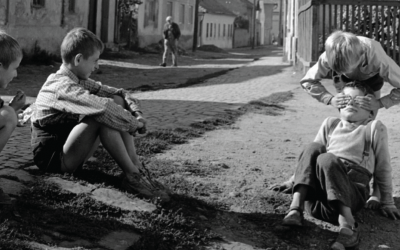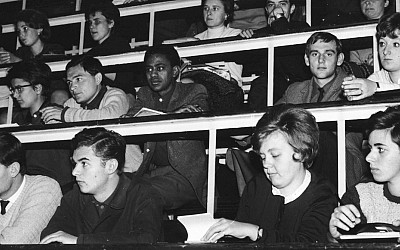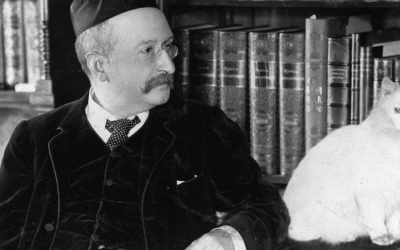Ellen Clarke on the biology of cooperation and its implications for understanding human behaviour.
The front door is unfamiliar, just one more chunk of wood among the countless doors that I pass by unthinkingly every day. I hesitate, listen for sounds of life from within, but everything is quiet, and the door yields soundlessly to my touch. It takes a while to find a light switch, but once I do a warm glow illuminates the flat. I potter for a while before settling, perusing the book shelf, scanning the title of the novel by the bed, noting the dubstep on the cd rack, wondering if the fridge will yield milk, or beer, or only mould. “This lamp is nice,” I think, “maybe it would suit my own house,” before showering, lathering my skin with a stranger’s scent, and then climbing into her bed to go to sleep.
No, I haven’t taken up stalking female celebrities. I’m speaking instead about one of my recent adventures in Airbnb-ing. This peer-to-peer web service matches up users who need a place to stay with providers who are willing to rent out their private home for the night. The provider in this case wasn’t going to be in town, so she emailed me her address and door code in exchange for a modest fee, and there I was making myself comfortable in the home of someone I had never, and probably would never, meet.
For a while, the received wisdom of the evolution of cooperation literature has been that such exchanges like the ones that take place via Airbnb shouldn’t happen. Each participant in such an interaction accepts only a modest benefit (a place to sleep, a small fee) in exchange for considerable risks. The vendor might have wildly exaggerated the assets of the accommodation. She might have provided a false door code, just to get my money. I might have entered a trap, in which the vendor was waiting to rob me in my sleep, or worse. On the other hand, once I’m inside her home, what is to stop me from helping myself to her shampoo, nicking the lamp, changing the locks and refusing to leave? Users have reported having all kinds of terrible experiences using Airbnb: thefts, renters turned squatters, trashed homes and stolen identities. Yet this “revolution in accommodation-seeking” had 2.5 million users in 2012 and has the traditional hotel industry so worried that they are trying to get it banned in several cities.
Why do people enter into such risky bargains? And why, once in them, don’t they tend to nick the lamps? Welcome to the problem of cooperation, a field which straddles a huge number of academic departments, from economics to anthropology, psychology to evolutionary biology, and aims to explain, in a world in which so many interactions have a structure which allows cheats to prosper at the expense of honest co-operators, why do agents cooperate? And how, furthermore, might we get them to cooperate more?
In biology cooperation (or altruism) is defined as behaviour which is costly to the actor and beneficial to some recipient, where these costs are understood in terms of fitness: reproductive advantage. Since the inception of the field in the late 60s, the consensus has been that cooperation in the strictest sense is impossible. No organism which behaves in a way which makes it less fit can survive the survival of the fittest. In the human sciences costs and benefits are understood as subjective payoffs. Here too, cooperation in games such as the Prisoner’s Dilemma (where the payoffs are ordered such that, whatever your partner chooses to do, your own score is always highest if you cheat) was viewed to be inexplicable. It’s just not rational to take a lower prize than is available and to leave yourself vulnerable to the mercy of the other player. Cooperation – the occurrence of mutually beneficial interactions in which neither party cheats to take advantage of obvious gains – shouldn’t happen.
There are several reasons why, despite this, cooperation wasn’t totally written off as an activity of the impaired or deranged. One of them is the Major Transitions literature. Lynne Margulis, along with Maynard Smith and Eörs Szathmáry, can be credited for bringing the world’s attention to the fact that most of the objects we take for granted as primitive elements in the natural world – organisms, in other words – were in fact constructed out of smaller building blocks. Human beings are the end-product of an iterative process which has built aggregates out of aggregates out of aggregates of separate, cooperating agents. We are mobile agglomerates of what used to be separate cells. Our cells are unions of separate prokaryote species. Prokaryote genomes are themselves alliances of separate genes. The hierarchical structure of life proves that cooperation is not just something we sometimes do, it is the cornerstone of biological evolution and the process that brought us into existence.
So we have transitioned from seeing cooperation as a marginal activity, limited to a few obscure phyla as in lichens, or present only as a fleeting, maladaptive error, to accepting it as ubiquitous, eternal and the central organising principle of life. It plays a critical explanatory role in the behaviour of birds and bees, bacteria and nerve cells, plants and genes and cancer cells, as well as the organisation of objects at multiple hierarchical levels. Some now even define the individual organism in terms of cooperation (see Queller and Strassmann 2009).
The cooperation literature has been mostly focused on spelling out various ways in which apparent cooperation can be explained by better understanding what the real payoffs are, so that what initially looks altruistic is revealed as serving the overall, long-term interests of the evolving agent. Evolution is not about the survival of the less fit, full stop. But fitness effects can be complex and convoluted, so that a strategy that appears costly might in fact be beneficial on a longer view of things.
Ugly disputes have broken out about the most widely applicable, or most elegant, or most sophisticated manner of performing this disclosure. In Kin Selection Theory, the cost to the organism’s reproductive chances is balanced by an indirect benefit to relatives who carry the same genes. In Multilevel Selection Theory, the cost to the individual is balanced by a benefit to the group. In Decision Theory, the short-term cost is balanced by the long-term prospect of reciprocation, or the benefits to self-esteem. Then there are obscure side-effects, interaction patterns and coordination procedures, all of which ensure that, whatever it may look like, the behaviour in question is self-serving after all. Somewhat confusingly, Inclusive Fitness Theory (Kin Selection’s modern update) expands the notion of relatedness to encompass genetic assortment by any means. The interactors need not be kin, in other words, they merely need to both be members of the cooperative type. The very broadest view collects all the other mechanisms together under the single banner of assortment. Kinship, group-membership, signalling and clustering are all just different means of raising the probability that when a cooperative behaviour is carried out, it is another co-operator who receives the benefit. Once assortment is in place, defectors struggle because they end up mostly interacting with other defectors.
In addition to explaining how the relationship between the donor and the recipient can affect the stability of the interaction against cheats, recent work seeks to shed light on what the point of cooperating is anyway. What is it about social ventures, in other words, that makes them often more profitable than going it alone? The two problems are entwined, because in those interactions in which the partners are very different from one another, it stands to reason that each might gain by bringing their different strengths together. On the other hand, those partners that are most alike are in a better position to trust one another, but it’s less obvious what they have to offer. As David Queller has pointed out, clonal brothers are excellently placed to solve the free rider problem, but there is a much smaller scope for synergistic interactions between them, as compared to the different species of a mutualism. It seems that the less the partners stand to lose from one another, the less they also stand to gain.
As well as settling how to keep cheaters from dodging their share of the labour, or from manipulating their share of the profits, the achievement of cooperation requires means of coordination. How is the labour to be divided? How are the interaction partners to be chosen? How will each partner know when it is time to play his part? How can the overall strategy be made sensitive to the changing conditions in which the cooperative venture is played out?
Evolution has hit upon many different solutions to these problems, each specific to the idiosyncrasies of the species and its environment at that time, such as the nature and scope of the free-rider threat, the abilities of the partners in question, the complexity of the group task. For example, bacteria use a signalling system dubbed “quorum sensing” to find out when sufficient interaction partners are present to begin working on a group task. Ants use pheromones, age-specific behaviours and special diets to divide the labour between their members. A sort of invisible hand modulates colony foraging behaviour, in some ant colonies, in response to changing availability of food in the local environment. Each forager responds individually to the rate at which it receives signals from incoming foragers, but the overall result is a delicate sensitivity of whole-colony behaviour to current conditions. Mole rat cooperatives are hierarchical, with control imposed from above by the matriarchs of each group. Metazoan cell lineages are also hierarchical, with gene transcription powers being increasingly removed as one moves down a somatic cell lineage, and reproductive privileges clutched in the control of a tiny, tightly-guarded minority.
We are discovering more and more ways in which biology has bequeathed humans with cooperation triggers and short-circuits. Japanese companies have known for years that making your workers participate in mass tai chi sessions improves their group cohesion. We now know that participation in synchronised physical movements triggers the release of endorphins in our brains, making us feel more bonded to and more likely to cooperate with our partners in the activity. I recall feeling desperately sorry for a flatmate of mine whose weekend job on a supermarket checkout required him to do “the Walmart Wiggle” at monthly meetings. Of course, religions and armies caught on years ago to the group-bonding power of synchronised movement.
Human emotions have been suggested as functioning to police cooperation, with guilt increasing honesty within a group, romantic love serving as a commitment device for reproductive cooperation, and disgust constituting a deeply-felt over-ride to cooperative intentions. We know that just gluing a poster showing a pair of eyes above an honesty jar makes users more likely to pay. And it might be that we love soap operas so much because they exercise our innate facility and enthusiasm for gossip, for the dissemination and articulation of information concerning the cooperative reputations of our peers.
As gross modifiers and constructors of our own niche, human cooperation has long been under cultural, as well as biological, selection. We are masters in the creation of arbitrary markers that will advertise our affiliation to a group. We fabricate cultural myths and icons that create justification for the demarcation of one group against others. We have institutionalised commitment devices such as engagement rings, which make the choice of defecting on a future marriage partner a little less attractive by making it cost rather more.
One of the pioneers of the field of cooperation studies was Robert Axelrod. He studied cooperation in order to find out how to get more of it. In a tale that is now legendary Axelrod set about studying the matter by inviting scholars to play a huge game of Prisoner’s Dilemma. In this game, the players meet each other in pairs and have to choose to between two options, whose score depends on what the other partner chooses. “Cooperate” scores 3 if matched by the other player, but only 1 if unmatched. “Defect” scores 2 if matched by the other, but 4 if not. Axelrod put all the players in a grand tournament in order to find a winning strategy. The result was, at first, a clear and earth shattering victory for a strategy that was decidedly cooperative. “Tit for Tat” initiates each new relationship (i.e. when playing the first round against each player) by choosing to cooperate. After that, Tit for Tat earns it name by just doing whatever the other player did last time. The world reported that the secret to successful interactions is to be nice.
In the years that followed, that result has turned into a resounding “not so fast”, with subsequent research showing that there was rather an element of luck in the winning strategy’s victory, that other, less nice players would have won had they been entered. It was crucial, first of all, that Axelrod’s tournament made players play over and over. One-shot prisoners’ dilemmas are insoluble, i.e. it only makes sense to defect. But put players in an iterated situation, where they can learn from their experience and keep track of the history of their interactions with other players, and suddenly cooperation becomes not just reasonable, but a potentially winning (high-scoring) strategy. Successive experts have improved on Tit for Tat by designing strategies that are able to break free where Tit for Tat gets locked into ongoing cycles of defection, as well as strategies that are so “grim” that even Tit for Tat gets mauled in competition with them. Nonetheless, the tournament and Axelrod’s brilliant analysis of it have generated a huge field which has yielded many priceless insights to biologists, to philosophers, to governments and to everybody else.
Here is some advice, from Axelrod and others, on how to make people cheat less:
- Make them feel more confident that cooperation will be reciprocated by:
- Reducing the effective group size, so that interactors are more likely to meet each other again.
- Facilitating accurate information about partner history, using social reputations, transparency.
- Improving recognition capabilities or enabling the players to signal, share information.
- Make cheating more expensive, by imposing additional costs using:
- External threats and promises via laws, police forces, armies.
- External sources of commitment, such as contracts, deposits, trade.
- Internal sources of commitment, such as value systems, emotions, social norms.
But have we, as a species, become more cooperative, or less, in the course of evolution? Some people take humans to be distinctive in the extent and complexity of their cooperation. On this view, the need to monitor interactions, to avoid cheats, and to coordinate group activities, was what drove human intelligence and enabled our eventual domination of every niche on the planet. Others instead think of cooperation as an ancestral state, arguing that we were members of social collectives first, and that individualism is a much more recent phenomenon.
All this goes back to issues concerning what is our human nature, and has long been associated with political philosophical commitments. If our nature is fundamentally competitive, red in tooth and claw, then some take this as supporting social and economic conservatism, survival of the fittest in the marketplace. If our evolved essence is cooperative, collectivist, on the other hand, then modern capitalism is a distortion of our natural order, and we can’t find happiness until we shake off these recent consumerist perversions. The dichotomy has a long pedigree, but that it is false is evidenced by alternatives: Peter Singer’s Darwinian Left, for one, Haim Ofek’s Cooperative Marketeering, for another. We won’t settle normative questions about right versus left by studying the evolution of cooperation. But we can hope to better understand what conditions and mechanisms might help to push a system towards either one equilibrium or the other. We might learn something about which sort of coordination problems can be solved by hierarchical order, and which by egalitarian organisation.
Axelrod recognised the field’s applications as ranging from the grandest problems of public policy and international relations (How can two nations negotiate mutual disarmament?), to the simplest matters of our personal lives (How many times will we invite acquaintances for dinner if they never invite us over in return?) to the most prosaic biological conundrums (Why doesn’t the shark eat the cleaner fish once it’s dental checkup is done?) Big business was quick to identify the potential competitive advantages made possible by the study of cooperation, but for Axelrod the goal was always to serve more altruistic ends, to apply biological lessons to make the world a more cooperative place (a goal still sought today in D S Wilson’s “The Neighbourhood Project”).
In some ways, the success of Airbnb speaks against all the received wisdom of the evolution of cooperation literature. The vendor and I don’t know each other, we certainly are not kin. We are unlikely to interact with one another ever again, especially if I’m on a city break. Yet here are two people – two strangers – who are putting themselves in exceptionally vulnerable positions on each other’s account, for fairly low pay offs.
Of course there are various rules and penalties designed to prevent Airbnb users from taking advantage of each other, in addition to the regular laws that countries enforce against murder, theft and so on. Basic ID and credit card checks go some way to protecting users. Nonetheless, the website is carefully designed to emit vibes about trust, community, friendship, rather than shouting about punishments or safety. Some users probably get a psychological boost out of identifying with this adventurous, anti-establishment, switched-on community (one of those convoluted, hidden payoffs to apparent cooperation). And in an example of how complex things can get when cooperation “games” are nested inside one another, Airbnb itself compensates users in order to protect its own reputation.
But there are two features that probably do most to underpin the relatively cheater-free operation of Airbnb and other peer-to-peer services such as RelayRides, TripAdvisor and eBay. One is the reliance on a rating or review system. This allows users to build up an online reputation, from which others can glean indirect information about how a person is going to behave, based on her interactions with third parties. In an age where “community” is more likely to be found online than in any geographic locale, reviews systems perform the role once carried out by village gossip.
Equally important and, perhaps, less obvious is the role of the user profile. These are much more than mere avatars. It is not really about making yourself less of a stranger, because there is no pretence that the interaction will be iterated. As on dating websites, on which users seek to choose a partner for the biggest cooperative challenge of all, writing the profile is all about signalling to other players about what sort of partner you will be. But it is no use just declaring yourself honest (or fun, or good-looking, or whatever the other users are looking for). Since the profiles are self-authored, such assertions won’t count for much. What’s needed is some kind of hard-to-fake signal.
One strategy is to litter your profile with cues signalling your membership of some group. Throw in personal details to prove you have the expected nationality, that you’re not computer generated, or a fronting a commercial business. But more importantly, a few details so that you can be identified as a member of a social tribe: a little left-leaning here, a nod to being literary there. Maybe you enjoy real ale. Maybe there is a bicycle visible in your profile picture, or it’s a shot of you performing at your local open-mic night. Other members of this type – middle-class, educated, urban – can pick these cues up and use them as a basis upon which to assort with you. Once a user has identified you as a member of their social tribe they are much more likely to trust you, to want to cooperate with you. You are someone they might chat to in a café, someone their sister might date. “We’re from the same cultural clan.....” the profile whispers, “Trust me!”
The user profile is an assortment device, a source of honest signals to help us find people who share our values, whom we can rely on. Liberals, goths, mods and rockers, wine snobs or born-again Christians … we humans like to assort with partners who we deem to be co-members of some culturally constructed group. Axelrod explained that arbitrary observable markers, just as much as anything with an objective basis such as sex, support stable stereotypes, in which players act under the assumption that their partner will behave similarly to others of that label. What’s more, these stereotypes can become self-confirming, because once everybody expects a certain behaviour of you, it’s optimal to exhibit just that behaviour. If people expect you to cheat, they’ll try to cheat you first, so you’d better not become the sucker.
The signals we send are generally reliable because, thanks to the notoriously rapid pace at which cultural tribes evolve (hipster, anyone?), they are difficult to fake. You have to be a genuine signed-up member of a clique to have any chance of getting it right.
We have learnt much about the powerful cooperative forces that have shaped and built living organisms. In a 2007 paper the evolutionary biologists Stephen C Stearns asked, of humanity, “Are we stalled part way through a major evolutionary transition from individual to group?” His supposition was that cultural group selection has brought about sufficient genetic change that people are in many ways optimised for group traits. In other words, many of our innate drives serve group-level purposes, rather than promoting our selfish interests as human beings.
Stearns doesn’t think the transition is likely to be completed, for technical reasons to do with heritability. So he doesn’t think that men and women will likely ever end up as mere parts whose interests are subjugated to that of a greater whole. But it is hard to resist imagining this dystopian sci-fi future. It is a world in which a totalitarian Marxist dream is realised, where individual humans cease to exist as separable agents, only a handful of elites reproduce and all the others sacrifice their every effort unquestioningly to the support of those elites. Of course it sounds terrifying, immoral, but biology knows no morality and did not hesitate before imposing the very same fate on our cells. Will a future, more advanced morality mourn the cruelties imposed on these cells, our own ancestors? Might we one day celebrate the heroic individualistic rebellion of cancer cells, just as the west celebrated those who fought the dehumanising shackles of soviet communitarianism?
Of course not, but the point is that the tension between our collectivist instincts and our individualist instincts is ancient and pervasive. In-group/out-group distinctions colour much of our interaction with one another, with sometimes very profitable but sometimes most horrific consequences. Many of the most important domains of human intellect are touched by issues about how to balance the interests of wholes against parts. We can do no better to further these issues than to ask mother nature why she sometimes tips the balance one way or the other, how she does it, and what the consequences are.
ELLEN CLARKE IS A PHILOSOPHER OF BIOLOGY WHO WRITES ABOUT COOPERATION IN PLANTS, BACTERIA AND PEOPLE. SHE IS POSTDOCTORAL FELLOW AT ALL SOULS COLLEGE, OXFORD.
Further reading
Samir Okasha Evolution and the Levels of Selection (Oxford University Press, 2006).
Kim Sterelny, Richard Joyce, Brett Calcott and Ben Fraser (Eds) Cooperation and Its Evolution (MIT Press, 2013).
{fastsocialshare}





